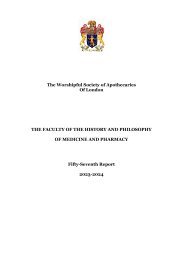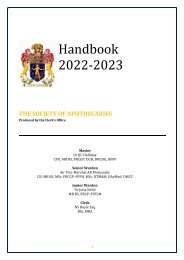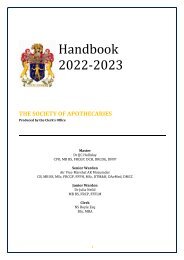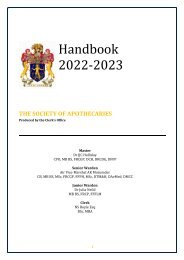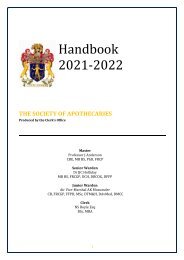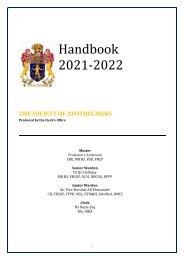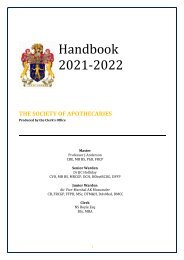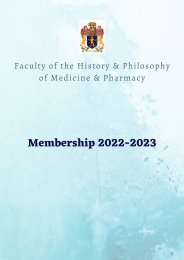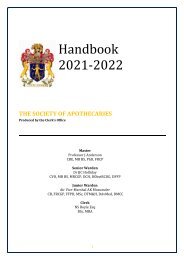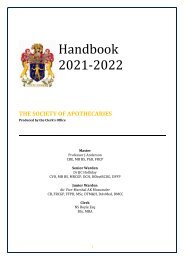Create successful ePaper yourself
Turn your PDF publications into a flip-book with our unique Google optimized e-Paper software.
The first examination for the Licence of the <strong>Society</strong> of Apothecaries (LSA) was held in August 1815.<br />
John Keats, the poet, qualified LSA in July 1816, and Elizabeth Garrett (later Garrett Anderson)<br />
gained her LSA in September 1865, and so became the first openly female recipient of a medical<br />
qualification in Britain. Ronald Ross, who in 1902 became the second Nobel Prize winner in<br />
Medicine, obtained his Licence in January 1881.<br />
The title of the <strong>Society</strong> qualification was altered by statute in 1907 to become The Licence in<br />
Medicine and Surgery of the <strong>Society</strong> of Apothecaries (LMSSA). Examination for the Licence is<br />
currently in abeyance. The Act of 1815 also gave statutory powers to the <strong>Society</strong> to also examine and<br />
grant a certificate called Assistant to an Apothecary, today’s Pharmacy Technician. This qualification<br />
finally ceased to be offered in January 1998.<br />
The <strong>Society</strong>’s role in medical education is also reflected in the range of specialist postgraduate<br />
diplomas that it pioneered. In 1928 it was the first body to introduce a qualification in Midwifery:<br />
the Mastery of Midwifery. This led later to the formation of the Royal College of Obstetricians and<br />
Gynaecologists. The Diploma in Industrial Health of 1946 later resulted in the founding of the<br />
Faculty of Occupational Medicine. One of the most recent diplomas, the Medical Care of<br />
Catastrophes, was encouraged by the Royal Army Medical Corps, and the Diplomas in Genitourinary<br />
Medicine and HIV Medicine are compulsory for those wishing to progress in those specialties. At<br />
present, the <strong>Society</strong> examines seven different postgraduate diplomas.<br />
Apothecaries’ Hall<br />
When the Apothecaries separated from the Grocers in 1617, the newly founded <strong>Society</strong> met in<br />
private houses, inns, and the Halls of other livery companies to conduct its business. In 1632 the<br />
former guesthouse of the Dominican Priory, in the district known as Blackfriars, was purchased. The<br />
<strong>Society</strong> immediately began a programme of improvements, furnishing and decorating the building in<br />
keeping with the status of a livery company. This Hall was destroyed by the Great Fire of London in<br />
1666, but a replacement was built on the same site between 1668 and 1672, incorporating<br />
significant sections of the Priory. The resulting Hall has remained essentially unchanged since that<br />
time, with only minor alterations. Miraculously, and through the heroic dedication of the<br />
firewatchers during the Second World War, it has survived virtually intact for more than three<br />
centuries. It is the oldest extant Livery Hall in the City and<br />
is a Grade 1 Listed Building and a Scheduled Ancient<br />
Monument.<br />
The courtyard was rebuilt in 1786 to provide warehouse<br />
accommodation for the storage of the drugs and medicines<br />
manufactured on the premises. The first laboratory was<br />
established underneath the Great Hall in 1672 and, before<br />
long, the <strong>Society</strong>’s large-scale production of drugs had<br />
become a thriving commercial enterprise which survived<br />
into the 20 th century. The client base included the Royal Navy, the Army, the East India Company,<br />
and Crown Colonies.<br />
Drugs, medical and surgical equipment, and related sundries were also sold in a shop at the Hall, and<br />
a retail pharmacy was opened in 1823 with its front door on what is now Black Friars Lane. The<br />
pharmaceutical businesses were finally sold in 1922. The old factory buildings were demolished in<br />
1929 and replaced with new offices, although the former Counting House, now known as Magnesia<br />
House, has been preserved. A new project that started in <strong>2021</strong> has restored the main entrance to its<br />
original location and re-created an ‘Apothecaries’ Shop’ on-site for the first time in almost 100 years.<br />
<strong>Society</strong> Treasures<br />
Over the years, many treasures have been given to the <strong>Society</strong>, many of which are displayed at the<br />
Hall. One of the most notable is a contemporary painting of the Spanish Armada, which hangs in the<br />
25



